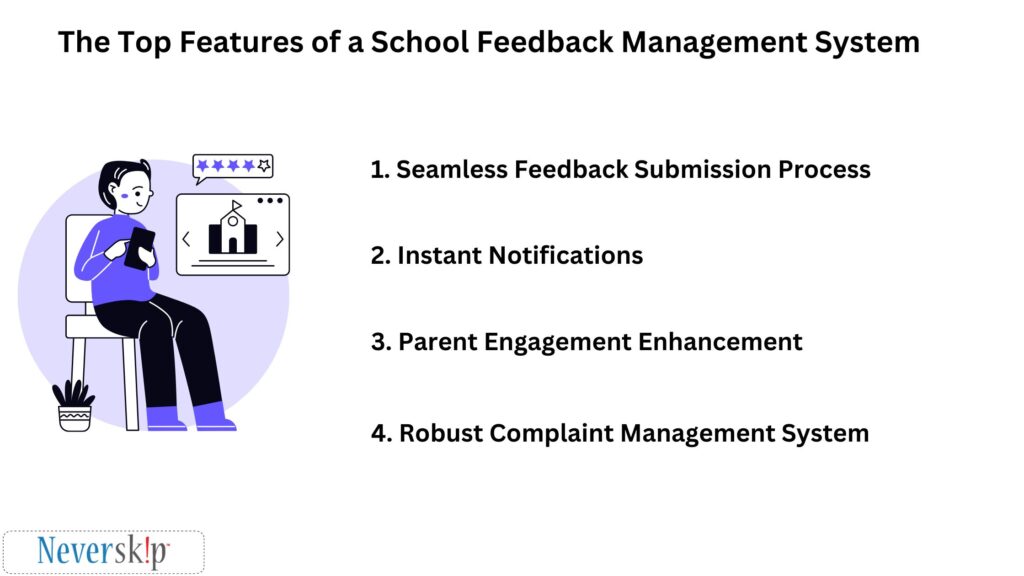Have you ever wondered how to transform your school’s feedback into tangible progress?
In the ever-evolving sector of education, the role of feedback has transcended from a mere assessment tool to a catalyst for meaningful growth. As schools strive to provide the best learning environment for their students, the significance of collecting, analyzing, and acting upon feedback cannot be overstated.
And that is where a School Feedback Management System comes into the picture. It is a technological marvel that has revolutionized how educational institutions gather insights from students, parents, and staff.
This blog delves into the pivotal role of these systems, dissecting their top features that not only streamline the feedback process but also amplify the positive impact it has on education. In an era where feedback is the bridge between aspirations and achievements, the growing adoption rate of these systems signifies their indispensable role in shaping the future of education.
Let’s know how!
What Is a School Feedback Management System?

A School Feedback Management System is a digital platform or software designed to collect, organize, and analyze feedback from various stakeholders within an educational institution, including students, parents, teachers, and administrative staff, to facilitate data-driven decision-making and improve educational processes.
This system typically encompasses a wide range of feedback sources, including students, parents, teachers, and administrative staff. Through surveys, questionnaires, and other data collection methods, it captures valuable insights regarding curriculum effectiveness, teaching methodologies, school facilities, student well-being, and administrative operations.
The primary purpose of a School Feedback Management System is to enhance the quality of education and the learning environment.
See More: Real-Time Tracking: The Advantages of Cloud-Based Attendance Management Systems
The Key Features of a School Feedback Management System

This comprehensive platform is designed to facilitate the collection, organization, and analysis of feedback from various stakeholders within a school or educational institution. Now let’s explore the key features of a School Feedback Management System, shedding light on how it can revolutionize communication and decision-making processes within educational settings.
1. Seamless Feedback Submission Process
Central to the functionality of a School Feedback Management System is its ability to provide a seamless and user-friendly feedback submission process. Here’s a closer look at the key features related to this aspect:
1. User-Friendly Interface
A well-designed School Feedback Management System offers an intuitive and user-friendly interface that allows all stakeholders, including students, parents, teachers, and staff, to easily submit feedback. The interface should be accessible on various devices, including computers, tablets, and smartphones, ensuring that users can provide feedback conveniently.
2. Customized Feedback Forms
To cater to the specific needs and requirements of different educational institutions, the system should allow for the creation of customized feedback forms. Schools can design these forms to gather feedback on areas such as curriculum, teaching quality, facilities, and student well-being. Customization options also enable institutions to add or remove questions as needed.
3. Multilingual Support
In diverse educational environments, multilingual support is essential. The system should be capable of handling feedback in multiple languages, ensuring that language barriers do not hinder effective communication. This feature is particularly important in schools with a culturally diverse student and parent population.
4. Anonymity Options
A crucial aspect of feedback submission is the ability for respondents to choose whether to remain anonymous or provide their identity. While some individuals may feel more comfortable sharing feedback anonymously, others may prefer to be identified. The system should offer both options to encourage candid feedback while respecting privacy preferences.
2. Instant Notifications
A School Feedback Management System goes beyond just collecting feedback; it also streamlines the process of addressing concerns and issues raised by stakeholders. Instant real-time notifications are a pivotal feature in this regard:
1. Immediate Alerts
Upon submission of feedback or complaints, the system should generate immediate alerts to the relevant parties. For instance, if a student reports a bullying incident, the system should notify school administrators and counselors in real-time, enabling swift intervention.
2. Escalation Paths
To ensure that critical issues are addressed promptly, the system should include predefined escalation paths. This means that if a complaint or concern is not resolved within a specified timeframe, it automatically escalates to higher levels of authority. This feature ensures that no issue falls through the cracks.
3. Communication Tracking
A comprehensive feedback management system keeps track of all communications related to feedback and complaints. This includes timestamps of when feedback was submitted, who it was assigned to, and the resolution status. This tracking feature enables transparency and accountability in addressing stakeholder concerns.
4. Resolution Monitoring
In addition to tracking communication, the system should also monitor the progress of issue resolution. Stakeholders, including complainants, should be able to check the status of their concerns in real-time. This feature fosters trust and transparency in the resolution process.
3. Parent Engagement Enhancement
Parent engagement is a critical aspect of a successful educational institution. A School Feedback Management System offers several features to enhance parent engagement:
1. Parent Portals
The system should provide dedicated parent portals where parents can access important information, submit feedback, and view updates on their child’s education. These portals should be user-friendly and easily accessible.
2. Direct Communication
To facilitate direct communication between parents and teachers, the system should offer messaging or chat features within the parent portal. This enables parents to discuss their child’s progress, ask questions, and receive updates without the need for physical meetings.
3. Event Notifications
Parents should receive event notifications, such as upcoming parent-teacher meetings, school events, or important announcements, through the system. This ensures that parents remain informed and engaged in their child’s educational journey.
4. Progress Tracking
Parents should be able to track their child’s academic progress and attendance through the system. Providing access to grades, attendance records, and teacher feedback fosters a stronger partnership between parents and the school.
4. Robust Complaint Management System
In addition to general feedback, a School Feedback Management System should also excel in managing and addressing complaints effectively. Here are the key features related to complaint management:
1. Comprehensive Logging
The system should comprehensively log all complaints, recording details such as the nature of the complaint, the parties involved, dates, and any attached documentation. This detailed record-keeping is crucial for investigations and audits.
2. Assignment and Prioritization
Complaints should be automatically assigned to the relevant personnel based on predefined criteria. Additionally, the system should allow for prioritization, ensuring that urgent or critical complaints receive immediate attention.
3. Investigation Workflows
A well-designed system should support the creation of investigation workflows. This means that when a complaint is received, it follows a predefined process for investigation, documentation, and resolution. Workflows can be customized to match the institution’s specific procedures.
4. Documentation Repository
All documents related to complaints, including correspondence, witness statements, and investigation reports, should be stored securely within the system. This centralized repository simplifies access and retrieval for future reference or audits.
5. Reporting and Analytics
A robust complaint management system should offer reporting and analytics tools. These tools allow educational institutions to analyze complaint data over time, identify trends, and take proactive measures to address recurring issues.
See More: Efficient Staff Management in Education: The Role of HR and Payroll Systems
The Bottom Line
In today’s fast-paced educational landscape, the importance of effective communication, efficient issue resolution, and enhanced parent engagement cannot be overstated. A robust School Feedback Management System, such as Neverskip’s Feedback Management System, emerges as a pivotal solution to meet these crucial needs.
Neverskip’s system is designed with a comprehensive set of features that significantly elevate the educational experience for all stakeholders, and here’s why it’s crucial to opt for such a solution.
First and foremost, Neverskip’s Feedback Management System greatly improves communication between parents and schools. The system’s user-friendly interface allows parents to easily submit feedback, inquire about their child’s progress, and receive real-time updates on school events. This seamless communication fosters trust, transparency, and a stronger partnership between parents and educational institutions.
Increased parental engagement is another remarkable benefit of Neverskip’s system. With dedicated parent portals, direct messaging capabilities, and access to academic progress reports, parents are more actively involved in their child’s educational journey. This heightened engagement translates to better support for students and improved learning outcomes.
The core goal of any educational institution is to provide students with the best possible learning experiences. Neverskip’s Feedback Management System aids in achieving this objective by allowing all stakeholders to contribute their insights and concerns. By collecting feedback on curriculum, teaching quality, facilities, and student well-being, schools can make data-driven improvements that enhance the overall educational experience.
If you are yet to try it out, book a free demo now!








